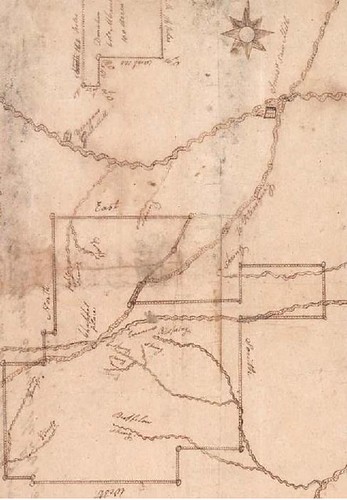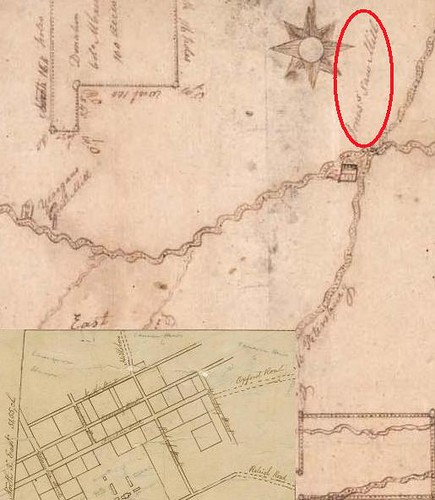
I had always assumed that the Jones Saw Mill was the same mill site that was located about where Martin Luther King Blvd crosses Bolin Creek (that is, the A J Brockwell Mill as shown on the 1891 Tate Map of Orange County).
But just this morning I was experimenting with superimposing some of the later maps of UNC onto the 1792 Daniel map to see what that might reveal. I was surprised to realize that the road next to the Jones Saw Mill is not MLK Blvd, but rather Franklin Street. It should have been obvious because the map identifies that road as going to Oxford, which would make it essentially US-15. Franklin Street is US-15-501 business and in that sense it goes to Oxford (among other places. Also MLK Blvd goes to Hillsborough, not Oxford.
Here's what the two maps look like when pieced together (shown at a slightly different scale than the map above):

So apparently there was an additional mill site on Bolin Creek: The Jones Saw Mill. That site was at the Franklin Street bridge over Bolin Creek, about where the Sunrise Biscuit Kitchen is today.
David Southern emailed to say (among other things): "I agree that the Jones saw mill was on the old Oxford Road, but when the Daniels map was drawn that road angled through the future Horace Williams [House] property and went down the long hill via Tenney Circle, where pieces are still visible in yards, driveways, and Bowling Creek Road."
ReplyDeleteDavid is right of course. So the mill would have been closer to where Village Green Condominiums are today or thereabout.
I looked at the deed for this property the other day. The deeds indicate that this mill was built by Hardy Morgan and sold to Edmund Jones in 1792. In 1793, Jones sold it to James Patterson.
ReplyDeleteSenator Hargett's notes on the selection of a site for UNC include the following detail (per Battle's History of UNC):
ReplyDelete“November 7th, 1792 . . . Mr. Edmund Jones made proposals for supplying plank and lumber, which are presented to the board.”
To be supplied from the Jones Saw Mill, we can only assume . . .
At the archives recently I stumbled across a mill petition to the Court of Pleas and Quarter Sessions from Edmond Jones in August of 1793. The petition asserts that Jones has a mill site (the nearest one to the site for the University, he says) that had formerly been a mill built by Benjamin Hart with the permission of the Court in about 1763 or 4, but that the records of the approval had been destroyed during the war. Jones sought permission to rebuild the mill, but the petition has the word 'Rejected' written on the back.
ReplyDeleteNow that I am back in Carrboro, I realized that I did not take note of what type of mill Jones had proposed, but I think maybe it was to have been a grist mill. Not clear on whether that would have been at the same mill site as the saw mill or perhaps just upstream at the A J Brockwell mill site near MLK Blvd./Airport Rd.
Great post. I've enjoyed looking at the engineering of the mill often. So cool how they used the water.
ReplyDeleteFYI, The Carrboro Greenways commission has received a report from Durham's Greenways Inc that includes a plan to put in a 10 foot wide paved transportation route next to the creek. This north south route, if it accepts DOT funds as planned, will need to be much wider than 10 feet to satisfy DOT requirements.
A new group, Save Bolin Creek, has formed to try to separate this natural area from Transportation planning.
Find us on yahoo groups, facebook, and on out blog: savebolincreek.wordpress.com/